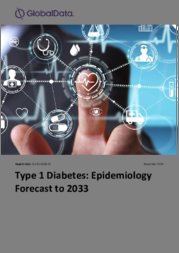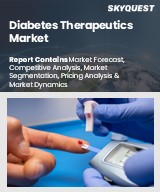
|
시장보고서
상품코드
1599072
1형 당뇨병(T1D) : 역학 예측(-2033년)Type 1 Diabetes: Epidemiology Forecast to 2033 |
||||||
본 보고서는 주요 7개 시장(미국, 프랑스, 독일, 이탈리아, 스페인, 영국, 일본)의 1형 당뇨병(T1D)에 대한 조사 분석을 통해 1형 당뇨병의 위험요인, 동반질환, 과거 동향, 2033년까지의 역학 예측 등의 정보를 제공합니다.
목차
제1장 1형 당뇨병(T1D) : 주요 요약
- 촉매
- 관련 보고서
- 향후 보고서
제2장 역학
- 질환 배경
- 위험인자와 합병증
- 세계의 과거 동향
- 주요 7개 시장 예측 방법
- T1D 역학 예측(2023-2033년)
- T1D 환자 수
- T1D 환자 수 : 연령별
- T1D 환자 수 : 성별
- T1D 환자 수 : BMI 카테고리별
- 저혈당 발증을 경험한 T1D 환자 수
- 취약형 당뇨병을 수반하는 T1D 환자 수
- DKA 발증을 경험한 T1D 환자 수
- 췌장 이식 대상이 되는 T1D 환자 수
- CKD를 수반하는 T1D 환자 수
- CVD를 수반하는 T1D 환자 수
- HLA-DQ8를 코딩하는 유전자를 1개 이상 보유한 T1D 환자 수
- T1D 총 환자 수
- 논의
- 역학 예측 인사이트
- COVID-19의 영향
- 분석의 한계
- 분석의 강점
제3장 부록
ksm 24.12.11T1D, formally referred to as insulin-dependent diabetes or juvenile diabetes, is a chronic autoimmune disease that predominantly develops in childhood and young adulthood and accounts for approximately 5-10% of all diabetes cases. It is caused by the body's immune system destroying pancreatic beta cells, which are responsible for producing a hormone that regulates blood sugar levels called insulin (Mobasseri et al., 2020). If T1D is left untreated, blood sugar levels increase, which can damage the pancreas and other organs (Mayo Clinic, 2024). As T1D is a chronic condition, it has a significant impact on the physical, psychological, and social wellbeing of patients.
Scope
- The Type 1 Diabetes Epidemiology Report and Model provide an overview of the risk factors, comorbidities, and the global and historical trends of type 1 diabetes (T1D) in the seven major markets (7MM: US, France, Germany, Italy, Spain, UK, and Japan).
- The report includes a 10-year epidemiology forecast for T1D, segmented by age, sex, body mass index (BMI) (underweight/normal [BMI <25kg/m2], overweight [BMI 25-30kg/m2], and obese [BMI >=30kg/m2]), hypoglycemic events (hypoglycemic and severe hypoglycemic events), brittle diabetes, diabetic ketoacidosis (DKA) events, and having at least one gene encoding for HLA-DQ8 for men and women of all ages. Additionally, the report also provides a 10-year epidemiological forecast for the diagnosed prevalent cases of T1D eligible for pancreas transplantation, with chronic kidney disease (CKD), and with cardiovascular disease (CVD) for men and women over 20 years old. The report also includes total prevalent cases of T1D for men and women of all ages.
Reasons to Buy
The T1D Epidemiology series will allow you to -
- Develop business strategies by understanding the trends shaping and driving the global T1D markets.
- Quantify patient populations in the global T1D markets to improve product design, pricing, and launch plans.
- Organize sales and marketing efforts by identifying the age groups, sex, BMI groups, disease conditions and genetic groups that present the best opportunities for T1D therapeutics in each of the markets covered.
- Understand magnitude of the T1D population by age, sex, BMI groups, associated disease conditions, pancreas transplant eligibility, and genetic groups.
Table of Contents
Table of Contents
- About GlobalData
1 Type 1 Diabetes (T1D): Executive Summary
- 1.1 Catalyst
- 1.2 Related reports
- 1.3 Upcoming reports
2 Epidemiology
- 2.1 Disease background
- 2.2 Risk factors and comorbidities
- 2.3 Global and historical trends
- 2.4 7MM forecast methodology
- 2.4.1 Sources
- 2.4.2 Forecast assumptions and methods
- 2.4.3 Forecast assumptions and methods: diagnosed prevalent cases of T1D - 7MM
- 2.4.4 Forecast assumptions and methods: diagnosed prevalent cases of T1D
- 2.4.5 Diagnosed prevalent cases of T1D segmented by BMI
- 2.4.6 Diagnosed prevalent cases of T1D that experienced hypoglycemic events
- 2.4.7 Diagnosed prevalent cases of T1D with brittle diabetes
- 2.4.8 Diagnosed prevalent cases of T1D that experienced DKA events
- 2.4.9 Diagnosed prevalent cases of T1D eligible for pancreas transplantation
- 2.4.10 Diagnosed prevalent cases of T1D with CKD
- 2.4.11 Diagnosed prevalent cases of T1D with CVD
- 2.4.12 Diagnosed prevalent cases of T1D with at least one gene encoding for HLA-DQ8
- 2.4.13 Forecast assumptions and methods: total prevalent cases of T1D
- 2.5 Epidemiological forecast for T1D (2023-33)
- 2.5.1 Diagnosed prevalent cases of T1D
- 2.5.2 Age-specific diagnosed prevalent cases of T1D
- 2.5.3 Sex-specific diagnosed prevalent cases of T1D
- 2.5.4 Diagnosed prevalent cases of T1D by BMI category
- 2.5.5 Diagnosed prevalent cases of T1D that experienced hypoglycemic events
- 2.5.6 Diagnosed prevalent cases of T1D with brittle diabetes
- 2.5.7 Diagnosed prevalent cases of T1D that experienced DKA events
- 2.5.8 Diagnosed prevalent cases of T1D eligible for pancreas transplantation
- 2.5.9 Diagnosed prevalent cases of T1D with CKD
- 2.5.10 Diagnosed prevalent cases of T1D with CVD
- 2.5.11 Diagnosed prevalent cases of T1D with at least one gene encoding for HLA-DQ8
- 2.5.12 Total prevalent cases of T1D
- 2.6 Discussion
- 2.6.1 Epidemiological forecast insight
- 2.6.2 COVID-19 impact
- 2.6.3 Limitations of the analysis
- 2.6.4 Strengths of the analysis
3 Appendix
- 3.1 Bibliography
- 3.2 About the Authors
- 3.2.1 Epidemiologist
- 3.2.2 Reviewers
- 3.2.3 Vice President of Disease Intelligence and Epidemiology
- 3.2.4 Global Head of Pharma Research, Analysis and Competitive Intelligence
- Contact Us

















